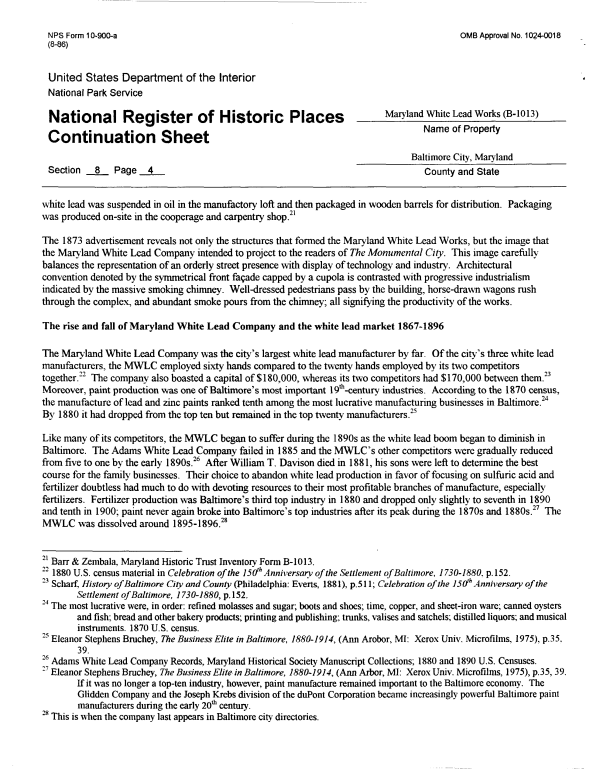 |
||||
|
DEPARTMENT OF HOUSING AND COMMUNITY DEVELOPMENT, MARYLAND HISTORICAL TRUST (Historic Sites Survey) var.d. MSA SE16-2 Image No: se16-2-0012 Enlarge and print image (89K) |
 |
||||
|
DEPARTMENT OF HOUSING AND COMMUNITY DEVELOPMENT, MARYLAND HISTORICAL TRUST (Historic Sites Survey) var.d. MSA SE16-2 Image No: se16-2-0012 Enlarge and print image (89K) |
| NFS Form 1 0-900-a OMB Approval No. 1 024-001 8 (8-86) United States Department of the Interior National Park Service Maryland mi* Lead works National Register of Historic Places ^ .. .. ~. . Name of Property Continuation Sheet Baltimore City, Maryland Section 8 Page 4 County and State white lead was suspended in oil in the manufactory loft and then packaged in wooden barrels for distribution. Packaging was produced on-site in the cooperage and carpentry shop.21 The 1873 advertisement reveals not only the structures that formed the Maryland White Lead Works, but the image that the Maryland White Lead Company intended to project to the readers of The Monumental City. This image carefully balances the representation of an orderly street presence with display of technology and industry. Architectural convention denoted by the symmetrical front facade capped by a cupola is contrasted with progressive industrialism indicated by the massive smoking chimney. Well-dressed pedestrians pass by the building, horse-drawn wagons rush through the complex, and abundant smoke pours from the chimney; all signifying the productivity of the works. The rise and fall of Maryland White Lead Company and the white lead market 1867-1896 The Maryland White Lead Company was the city's largest white lead manufacturer by far. Of the city's three white lead manufacturers, the MWLC employed sixty hands compared to the twenty hands employed by its two competitors together.22 The company also boasted a capital of $180,000, whereas its two competitors had $170,000 between them.23 Moreover, paint production was one of Baltimore's most important IQ^-century industries. According to the 1870 census, the manufacture of lead and zinc paints ranked tenth among the most lucrative manufacturing businesses in Baltimore.24 By 1880 it had dropped from the top ten but remained in the top twenty manufacturers.25 Like many of its competitors, the MWLC began to suffer during the 1890s as the white lead boom began to diminish in Baltimore. The Adams White Lead Company failed in 1885 and the MWLC's other competitors were gradually reduced from five to one by the early 1890s.26 After William T. Davison died in 1881, his sons were left to determine the best course for the family businesses. Their choice to abandon white lead production in favor of focusing on sulfuric acid and fertilizer doubtless had much to do with devoting resources to their most profitable branches of manufacture, especially fertilizers. Fertilizer production was Baltimore's third top industry in 1880 and dropped only slightly to seventh in 1890 and tenth in 1900; paint never again broke into Baltimore's top industries after its peak during the 1870s and 1880s.27 The MWLC was dissolved around 1895-1896.28 21 Barr & Zembala, Maryland Historic Trust Inventory Form B-1013. " 1880 U.S. census material in Celebration of the 150th Anniversary of the Settlement of Baltimore, 1730-1880. p. 152. 23 Scharf, History of Baltimore City and County (Philadelphia: Everts, 1881), p.511; Celebration of the 150th Anniversary of the Settlement of Baltimore, 1730-1880, p. 152. 24 The most lucrative were, in order: refined molasses and sugar; boots and shoes; time, copper, and sheet-iron ware; canned oysters and fish; bread and other bakery products; printing and publishing; trunks, valises and satchels; distilled liquors; and musical instruments. 1870 U.S. census. 25 Eleanor Stephens Bruchey, The Business Elite in Baltimore, 1880-1914, (Ann Arobor, MI: Xerox Univ. Microfilms, 1975), p.35, 39. 26 Adams White Lead Company Records, Maryland Historical Society Manuscript Collections; 1880 and 1890 U.S. Censuses. 27 Eleanor Stephens Bruchey, The Business Elite in Baltimore, 1880-1914, (Ann Arbor, MI: Xerox Univ. Microfilms, 1975), p.35, 39. If it was no longer a top-ten industry, however, paint manufacture remained important to the Baltimore economy. The Glidden Company and the Joseph Krebs division of the duPont Corporation became increasingly powerful Baltimore paint manufacturers during the early 20th century. 28 This is when the company last appears in Baltimore city directories. |